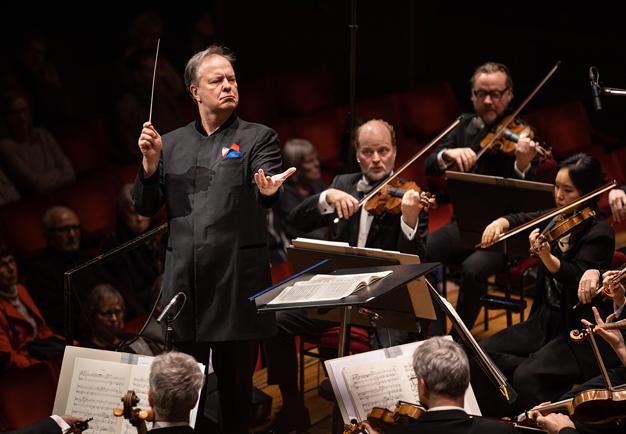Symphony No. 6

Sakari Oramo conducts the sixth symphony on May 29. Photo: Nadja Sjöström
The Cinderella of the seven symphonies. Not the most played, but possibly the best?
Jean Sibelius’ Symphony No. 6 was first performed by the Royal Stockholm Philharmonic Orchestra on 5 March 1923, conducted by Sibelius. It has been performed by the orchestra on a total of 32 occasions, including during a major European tour in 1989 and a tour of Japan – both led by Paavo Berglund. Symphony No. 6 was also performed on the occasion of Jean Sibelius’ 90th birthday in December 1955 led by Carl Garaguly.
Jean Sibelius
Symphony No. 6 d minor op 104 (1923)
Allegro molto moderato
Allegretto moderato
Poco vivace
Allegro molto
Duration approx. 27 minutes
The composition of the Sixth symphony was a protracted process. The first sketches are dated from the autumn of 1914, but the work on the piece was not complete until February 1923. For several years, Sibelius worked on two symphonies, the Fifth and Sixth, simultaneously. In December 1917 yet another symphony came into the picture: ”Have Symphonies VI and VII ’in my head’. As well as the reworking of Symph. V.”
From the beginning, he had material to start working, but no clear idea about where it belonged. A diary entry from December 21, 1914 points to a symphonic fantasia: ”Have been working on the orchestral fantasy.” And from March-April, an entry reads: ”Violin concerto II/Concerto lirico”. It is impossible to tell at what point in time the idea of a new symphony caused him to put the other ideas aside.
In September 1922 the symphony began to take shape: ”Working on the new one, that must be finished by January 1923.” Four days later: ”Have worked. Today, I felt the fullness of life and the greatness of my art.” And on October 14: ”Working on my new symphony. We will see if it gets finished.” Five days later, he feared that time would run out: ”Will I have the time for all the concerts next year, that is the question. A must!”
The first diary entry from the following year describes the development, but also that he is under duress: ”Oh my! I, II, III of Symphony 6 finished. Shaking and nervous.”
The premiere took place on February 19, 1923. Among Sibelius’ symphonies, the Sixth is ”Cinderella.” It has not reached the same heights of popularity as the others, but many Sibelius experts find it to be one of the best. On the surface, it is more traditional than the Fifth, since the character of the four movements are like those of a classical symphony. At the same time, the expectations for a traditional symphony are not met; it is as if something is ”wrong” and gives a curious impression.
There are above all two reasons for this unsatisfactory feeling. One is the fact that what at first seems to be an ordered row of traditional symphonic movements, where each has its own character, instead shows itself to be a continuum, revealing that the work was from the beginning meant to be a symphonic fantasia. The thematic material in all the movements is surprisingly homogenous, built for the most part on a stepwise melodic motion.
The second reason is that there does not seem to be any clear harmonic relationship between the movements and that which happens musically in them. Instead, there are subtle shifts, where Sibelius utilizes the possibilities for different functions inherent in the individual tones. As the British musicologist Tim Howell puts it, ”our presumptions about individual movements cannot be taken for granted; this applies especially to individual forms and the listener’s chances to understand the beginnings and ends of the internal forms.”
In Sibelius’ sketchbook (from the end of November 1914) one can find the first idea for the Symphony written down, a rising theme in E-flat minor, but with C (instead of C-flat) as the sixth tone in the scale, which means that it actually is a Dorian E-flat scale. The E-flat tonality shows that this was material originally meant for the Fifth symphony. Transposed a half-step down, however, it ended up in the Sixth symphony, which was given a Dorian D tonal frame. It is a church tonality that gives the work a chiaroscuro character. The formal and tonal characteristics have caused the Sixth symphony to be called both a symphony ”about” the symphony itself, and a symphony ”par excellence about tonality.” (Arnold Whittall)
— Ilkka Oramo
English translation: George Kentros
